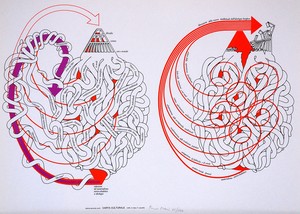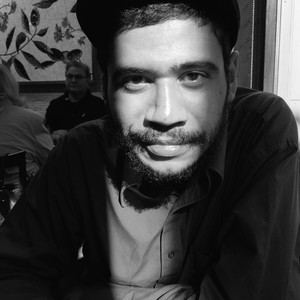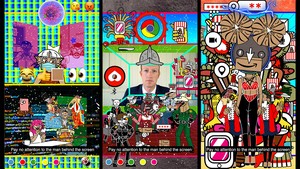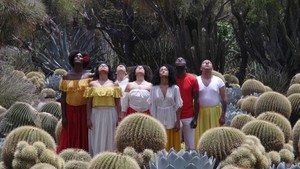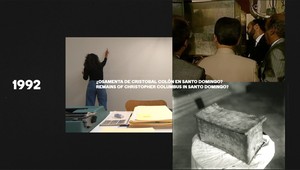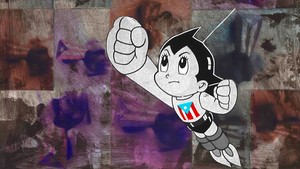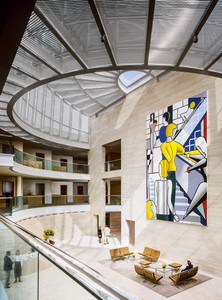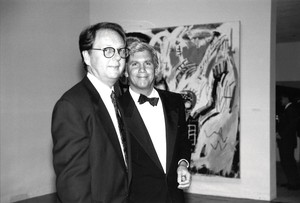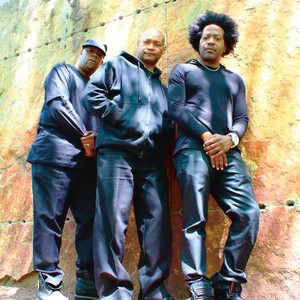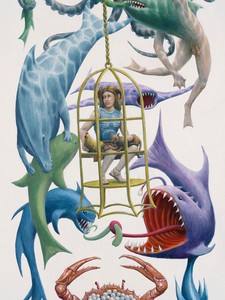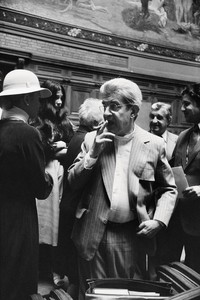How to film Latinidad? How to grapple with the unique combinations of African, European, American, and Asian roots that make up the vast, overdetermined histories of Latinidad? At the film screening event “Centering Latinx Video Art: Disrupting and Rewriting Colonial Narratives,” a kind of answer emerges. At Anthology Film Archives in New York, on November 30, 2022, Gagosian presented a selection of videos by Latinx artists who engage in destabilizing, disrupting, and rewriting colonial narratives. The artists featured—Michael Menchaca, Carolina Caycedo, Lizania Cruz, Juan Sánchez, and María Magdalena Campos-Pons—investigate colonialism and language from a place of solidarity with their respective Latine communities. From pop to the archival, and using historical documents, buildings, landscape, movement, and sound, they “reveal and memorialize suppressed histories while offering alternate understandings of the present.” What the work more than demonstrates is that a massive effort is underway to reconsider the place of Latinx America—its people, customs, and politics—in the cinematic imaginary. And that it emerges without the need for official confirmations, without paying heed to Sight and Sound polls that choose to ignore the rich output of an entire continent. Surely the work of these five artists, through their engagement with different categories of moving images to those we’re accustomed to interpreting (the Hollywood narrative, easy pleasures, the antipoetic), is properly destabilizing. These are visions of the future that take the present and past as one vast sheet, interrelated, mixed up, and forever unruly.
Michael Menchaca, A Cage Without Borders (2021)
“Unfollow us” and “CLICK TO UNSUBSCRIBE” are just two of the 202,967 or so phrases, images, and GIFs that explode across the screen in A Cage Without Borders, described by its artist/image-culler/montagist Michael Menchaca as an attempt to “hijack the commercial appeal of motion graphics on social media platforms in order to critique the US carceral state.” Three vertically-oriented strips of buzzing animation flash and skip over each other across the wide screen. Three worlds of the iPhone. Triple haywire. Triple the mental overload. Triple the smothering awareness of the “New Jim Code” times that Menchaca’s work invokes so viscerally. It links why we can’t pay attention to moving images for longer than ten minutes (if that), to the seizing of the collective US conscious by Silicon Valley, eager 21-year-old Stanford techies, and the newest of the new pandemic-proof digital revolutions. A white cop, threatened, shoots hearts and likes at me. I see a Latina singing “Como La Flor” on karaoke. Many TikToks speed by: “Being a Mexican in the military be like . . .” There’s a reason why I can’t pay attention to all the chaos on my phone for more than quick, brief bursts: I can’t be reminded of the mess wrought by Amazon, by brainwormed fascists who (après Benjamin) want to aestheticize politics, by a culture developed to normalize prisons, by podcasts, and Instagram Reels. Is the salve somewhere between the margins of a Tsai Ming-liang film, Michelle Alexander’s The New Jim Crow (2010), and the end of the world as we know it? Where’s the unsubscribe button? Or the Adderall? Menchaca gives us neither.
Carolina Caycedo, Apariciones/Apparitions (2018)
First presented as an installation at the Huntington, San Marino, CA, Aparaciones/Apparitions by LA-based, London-born Colombian artist Carolina Caycedo gains a different layer of melancholy within the theater of the Anthology Film Archives—a further displacement in which the “underrecognized histories of race, labor, and sexuality at the Huntington” evoke an even more profound ghostliness. There is the sense that messages are transmitted from the beyond that must be decoded via a fluid, precise translation. In an interview with Bomb Magazine, Caycedo describes growing up in Bogotá and the effect its streets had on her: “In order to be safe, I had to be streetwise and learn to read those with whom I shared the street. For that reason, I feel entitled to public space, to communicate through my presence, and by extension my work.” It goes a long way to explaining the force of her dance piece, suggestive of practices of the Candomblé religion and the goddess Oxúm, an Afro-Brazilian deity of water, pleasure, fertility, and sexuality. Black, brown, and queer bodies inhabit a space that, as we know, traditionally would have kept them subservient, exterminated, nonexistent. They twitch and suck and are double-exposed in a vast exorcising of the Huntington space. They paw and crawl down stairs. Streams of water trickle by. Their bodies hum against the plump cacti of the overworked Pasadena landscape. Everywhere we walk, they suggest, is a graveyard. The dead consume us, as one sees in François Truffaut’s The Green Room (1978) or Julie Dash’s Praise House (1991)—the latter could even be a sister-piece to Caycedo’s staged performance.
Lizania Cruz, Opening Statement (2021)
If Caycedo’s Aparaciones is a ghost tale, Lizania Cruz’s Opening Statement is a private detective yarn. She accumulates mounds of evidence to explore her thesis: her country’s racialized history and past—that of the Dominican Republic and its neighboring Haiti, the only state in history that was formed by a successful slave revolt—which has been not only covered up, but also whitewashed. Sebastián Meltz-Collazo, in an essay on Cruz’s 2021 exhibition Gathering Evidence: Santo Domingo & New York City at the CUE Art Foundation, New York, provides crucial context to the Dominican/Haitian racial imaginary:
As a result of nationalistic differences after colonial rule and slavery, the Dominican Republic positioned itself as a Hispanic nation that was made up of people of European decent. This motivated many to adopt conflated notions of identity, to the point that being Dominican meant being Catholic, of mainly Spanish descent, and most importantly, white; whereas the erroneous antithesis to this set of characteristics was to be Haitian, meaning voodoo practitioner, of African descent, and Black. In his book, A Case of Mistaken Identity: Antihaitianismo in Dominican Culture, Ernesto Sagás writes, “The black and the mulatto masses had but two choices: to ‘lighten’ themselves by assuming the Indio identity and Hispanic culture, or to be ostracized and excluded from the national mainstream.” Most notably under his rule, the dictator Rafael Trujillo [who ruled from February 1930 until his assassination in May 1961] implemented various strategies to solidify these beliefs, all striving towards a white, eurocentric society: from using makeup to whiten his skin, to committing the seldom known Parsley Massacre.
“Todo es herencia africano.” It’s a simple statement of fact and yet it rankles Cruz’s community, as evidenced by the sudden, brutally racist rant she records by a random Dominican man on the street who is asked his opinion of the Haitians. Cruz confronts the hatred against Black skin within the Dominican Republic, the colorism that not only pervades this country but also all Latin America, with its mix of American, European, and African heritage. Cruz’s detective act—she dissects the mystery with a clear answer on blackboards, mounting piles of paper, endless archival footage—serves not only to deliver history lessons, but also to demonstrate the art of archival practices. To work through an archive, like laying down a layer of color or taking the first camera shot, is hard work—unseen, unglamorous, but nonetheless necessary.
Juan Sánchez, Unknown Boricua Streaming: A Nuyorican State of Mind (2011)
There’s a synergy between Menchaca’s piece and Juan Sánchez’s hypnotic sound-and-image collage, Unknown Boricua Streaming: A Nuyorican State of Mind. Against a shifting background of charcoal-embedded, silkscreened Puerto Rican flags, we are privy to a dense layer of sounds (salsa drums, blasts of jazz horns) and images (Columbus, Black Panthers, Harriet Tubman, Che, a red rose up in Spanish Harlem, Dr. King, a Smiley Face, Attica, Malcolm X praying to Allah, Cesar Chavez, Popeye and Olive Oyl, Che in death, Allende, Fidel, the Young Lords—and that’s only some of what I could register on my first viewing). The piece is bookended by the thumping bass of Paul Chambers on the canonical 1959 recording of the Miles Davis/Gil Evans tune “So What,” which loops as if to induce a proper trancelike state in which to absorb the flashing sequence of images. Sánchez himself likens the work to that of Duchamp: “a leather box of memory.” Indeed, it feels like someone recalling all the oneiric signifiers that have loomed large since childhood—a mix of television, telenovelas, the sounds of the New York City streets, images of Puerto Rico, and a precise, expansive pop culture that incorporates Betty Boop, Richard Avedon’s photograph of Marilyn Monroe from Nothing Personal (1964), and the cover to the album Santana III. In the post-screening conversation, Sánchez mentioned Jonathan Demme’s 2004 remake of The Manchurian Candidate as a big reference point for him, particularly the “flashing” visuals used to brainwash soldiers to blindly serve US ideology during the Gulf War. Alongside the reference to the “Unknown Soldier” in the title of the piece, which Sánchez links to the status of the undocumented migrant, the piece points toward the eruption of a US cultural unconscious shaped by the consciousness of the Borinqueño point of view.
María Magdalena Campos-Pons (with sound by Neil Leonard), Matanzas Sound Map (2017)
Hay una conga que viene del monte,
a conga mining your curtains
from an abandoned asylum: cobwebs,
the long-awaited thirteenth tone,
the long-lusted-after you,
the God breathing me to kick
and dawdle and sulk just at the moment
when I’m tempted to sand down,
to clamp off, to identify and to melt
todo mi yo a ti—y con nada a decir,
to adumbrate a vile complex, powered
by such cheap oil and dextrose, filling
our reunion with plastered-in-Paris dreams.
This is no substitute.
We know the beats you’ll hit to set the scene: your blouse,
pinned to dry along the wires that drag our intimates
along the island phone-style. . . . Oh the marks, the beats!
like we had slaved through Thursdays, Sundays, matinees:
a drooping wet shimmer of a wall pooling sweat on your back
from the summer we gave Humberto his first coffee and cigs.
Why is the green on your mother’s curtains so misty-veily . . .
I don’t remember this carnation-rose pattern. Did she pick them?
No: she too left before she had the chance.
Peering through cane-river slats, your foot-dust rising,
I set to more brooming, more wiping.
You’ll ask. Yes, the good tile broke.
The fridge was like you left it.
I’ve raised myself into holy hell trying to get the room together,
but it wants you to hear it like it is. I don’t argue with it.
I do what it tells me to.
Epilogue
La arena de color
Contienen el sentido
De un grito de dolor
Que se convierte en cine clasico,
(ese santo estilo de la mentira)
después de unos siglos, poco a poco,
A una cuenta de alegría.
Campos-Pons declared in 1997: “Identity could become a tragedy,” perhaps in the sense of its potential for containing too soon, too harshly. By the end of the night, there was a rising conviction in me that, in fact, to intervene in the Latine imaginary and its self-imaginings in deforming-poetic-collaging ways, as Menchaca, Cruz, and company have so thoroughly demonstrated, will bring about a watershed change in the possibilities of how to imagine what Latinidad looks like in the 21st century. As Campos-Pons said: “The rainbow belongs to me, as a painter, so . . .”—now, with a shot of sarcasm—“I am sorry, buuuut . . .” I laugh. She’s quite not sorry.
